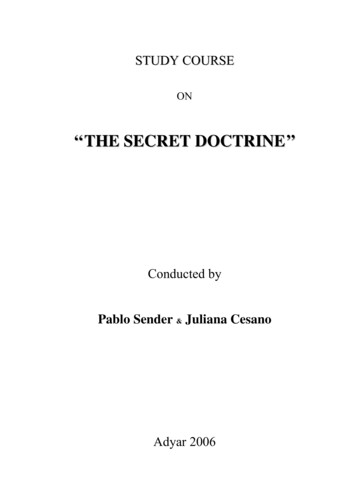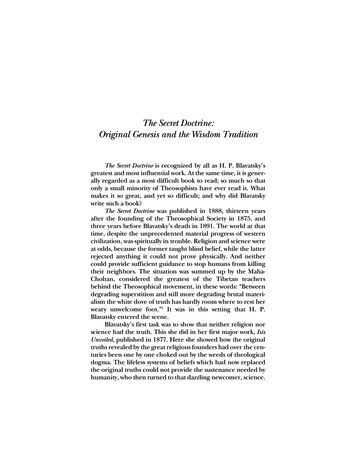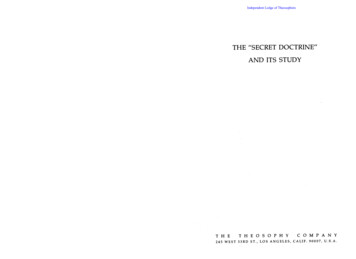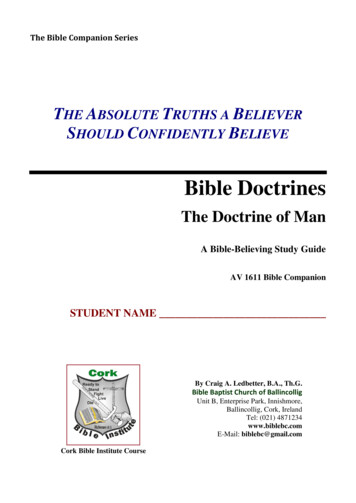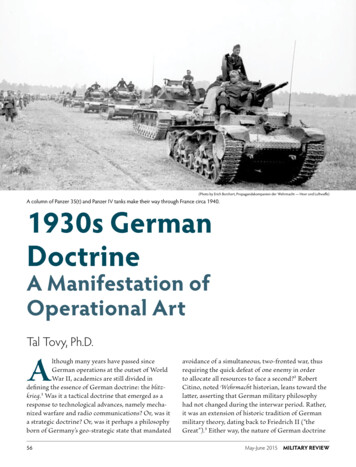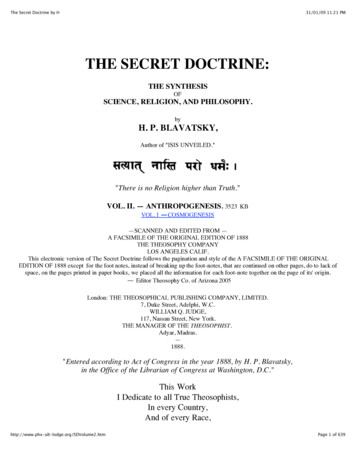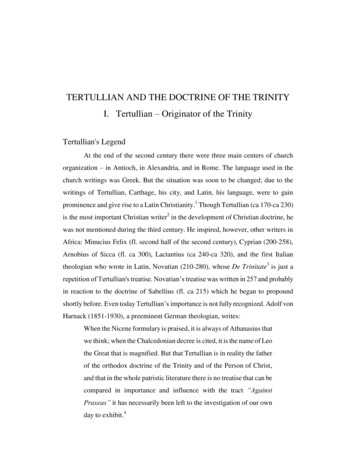
Transcription
TERTULLIAN AND THE DOCTRINE OF THE TRINITYI. Tertullian – Originator of the TrinityTertullian's LegendAt the end of the second century there were three main centers of churchorganization – in Antioch, in Alexandria, and in Rome. The language used in thechurch writings was Greek. But the situation was soon to be changed; due to thewritings of Tertullian, Carthage, his city, and Latin, his language, were to gainprominence and give rise to a Latin Christianity.1 Though Tertullian (ca 170-ca 230)is the most important Christian writer2 in the development of Christian doctrine, hewas not mentioned during the third century. He inspired, however, other writers inAfrica: Minucius Felix (fl. second half of the second century), Cyprian (200-258),Arnobius of Sicca (fl. ca 300), Lactantius (ca 240-ca 320), and the first Italiantheologian who wrote in Latin, Novatian (210-280), whose De Trinitate3 is just arepetition of Tertullian's treatise. Novatian‟s treatise was written in 257 and probablyin reaction to the doctrine of Sabellius (fl. ca 215) which he began to propoundshortly before. Even today Tertullian‟s importance is not fully recognized. Adolf vonHarnack (1851-1930), a preeminent German theologian, writes:When the Nicene formulary is praised, it is always of Athanasius thatwe think; when the Chalcedonian decree is cited, it is the name of Leothe Great that is magnified. But that Tertullian is in reality the fatherof the orthodox doctrine of the Trinity and of the Person of Christ,and that in the whole patristic literature there is no treatise that can becompared in importance and influence with the tract “AgainstPraxeas” it has necessarily been left to the investigation of our ownday to exhibit.4
2We do not know much about Tertullian, and what we know is primarily fromhis own writings.5 We know that Septimius Tertullianus6 lived during the reigns ofEmperor Septimius Severus (193-211) and his son Caracalla (211-217) in Carthage,and was probably born ca 170. He was brought up in a Hellene family and we haveno account of when he became a Christian. His last work can be dated with certaintyto the year 212, so it can be deduced that he died shortly afterwards, probably ca 230.In the Middle Ages his name, without any justification, was augmented to QuintusSeptimius Florens Tertullianus. Tertullian spent most if not all his life in Carthagewhere Apuleius of Madauros (ca 124-ca 170) also wrote.7 Apuleius was famous andolder, an important figure in Carthage as the provincial priest of Isis and Osiris, abarrister, poet, and historian. He was also a Platonic philosopher and a critic of theChristian movement, and consequently disliked by Augustine.8Table 1Suggested chronology of Tertullian’s writings9All Tertullian’s literary works come from the period 196-207 C.E.Year C.E.Titles196 or 197De SpectaculisDe IdolatriaDe Cultu Feminarum II197Ad NationesAdversus Judaeos197 to 198Ad MartyrasApologeticumDe Testimonio Animaebetween 198 and 203De BaptismoDe OrationeDe PaenitentiaDe PatientiaAd Uxorem203De Praescriptione Haereticorum203 or 204Scorpiace204 to 205Adversus Hermogenem205De Pallio2
3205 to 206206206 to 207De Cultu Feminarum IDe Carne ChristiAdversus ValentinianosDe AnimaDe Resurectione Mortuorumbetween 207 and 208Adversus Marcionem208De Corona Militis208 to 209De Exhortatione CastitatisDe Fuga in PersecutioneDe Virginibus Velandis210 to 211Adversus PraxeanDe MonogamiaDe JejunioDe Pudicitia212Ad ScapulamThrough the centuries, scholars and religious writers repeated the erroneouslegend about Tertullian created by Eusebius of Caesarea (263-339) and Jerome (345440). This legend was discredited by exhaustive studies conducted by Timothy DavidBarnes.10 It will be useful to summarize briefly his arguments.Eusebius reported in his History of the Church, written sometime between309 and 326, that Tertullian was “an expert on Roman law and famous on othergrounds – in fact one of the most brilliant men in Rome.”11 There is no evidencewhatsoever that he has ever been in Rome, though it is likely that he visited thiscity.12 Eusebius knew only Tertullian's Apologeticum and since Tertullian often citesRoman law, e.g., one statute that in Rome no one could be regarded as a god unlesshe had been approved by the Senate, Eusebius probably drew his conclusion.Tertullian may have been educated in Rome but he spent the greater part of his life inCarthage where he was, as Cassiodorus (487-580), a Christian senator correctlypoints out, a teacher of rhetoric, a Christian sophist, and that he belonged to the sameliterary circles as Apuleius. Tertullian's enormous erudition and his thorough classicaleducation in which rhetoric was the queen of subjects, point unmistakably to this3
4conclusion.13Eusebius made a total of five references to Tertullian's treatise.14 He had anextremely limited knowledge or none at all of the Latin writers. Legend also has itthat Tertullian composed two legal textbooks De castrensi peculio and six volumesof Quaestiones15 which are cited in the Digest and Institutions of Justinian16 asauthored by a certain “jurist” Tertullianus. The surviving fragments17 give littleinformation on their scope. The law relative to castrense peculium originated withAugustus and dealt with the acquisitions during service that a soldier could claim ashis own. No conclusion can be made as to the date of these laws. The other book,Quaestiones, deals with a series of problems unrelated to the previous legal issues.For the chronology it is important to note that one of the opinions of the juristTertullian is cited by Ulpian who, under the rule of Caracalla, wrote a verbal opinionfrom Sextus Pomponius. So it was deduced that the jurist Tertullian was the pupil ofPomponius and thus born ca 150. But nobody ever established any connectionbetween the jurist and the Christian writer. They may have been contemporaries andEusebius might have thought that they were one person. Knowledge of law was notan exclusive prerogative of jurisconsultants, it was rather a general need for anypublic speaking, and ancient education in oratory required knowledge of law. AllLatin writers were knowledgeable of the law and made use of it. There were thusprobably two contemporaries – the jurist Tertullianus who may have been a discipleof Pomponius and was born ca 150, and the Christian writer, who was a Christiansophist and rhetorician in Carthage, born ca 170. The treatise Ad uxorem18 suggeststhat Tertullian was already a Christian when he married a Christian wife. Eusebiusprobably heard of the jurist and confused him with the Christian writer. Moreover,many scholars emphasize that Tertullian's legal terminology influenced histheological statements and cite this as evidence of his being a jurist. However,Lactantius19 makes no comment on Tertullian‟s legal knowledge. If he were a juristhe would know that there was no lex senatus consultum or imperial decree4
5prescribing Christianity as illegal, yet he acknowledges that Christians were treateddifferently and even speaks of a law against them.20Eusebius wrote his history in a triumphant period for Christianity when itgained the upper hand due to support from Emperor Constantine and followed thegeneral tendency among the early Christian writers to exalt Christians as knownfigures and of high social standing. The facts contradict this assumption – juristswere impervious to Christianity and the Roman Senate was largely “pagan” even inthe fourth century.21Eusebius knew only Tertullian's Apologeticum which was probably poorlytranslated into Greek. Eusebius also claimed that Tertullian was supposed to haveaddressed his Apologeticum to the Senate in Rome,22 but Eusebius deduced thiserroneous conclusion from the introduction to the Apology where Tertullianaddresses the magistrates governing Carthage as: “Rulers of the Roman Empire, if,seated for the administration of justice in your lofty tribunal, under the gaze of everyeye, and occupying there all but the highest position in that state,.” (Si non licetuobis, Romani imperii antistites, in aperto et edito, in ipso fere uertice civitatispraesidentibus ad iudicandum, palam dispicere et coram examinare, quid sit liquidoin causa Christianorum .).23Among other Christian writers Lactantius does not recognize Tertullian as ajurist or a priest.24 The presumed legal knowledge of Tertullian leaves much to bedesired. Tertullian often used legal terminology and legal language to formulatetheological concepts, but he was often mistaken. For example, there was no lex,senatus consultum or imperial decree proscribing Christianity as illegal.25 YetTertullian never makes a point of it. Although both Christians and criminals weretried by the same legal process, the punishment of common criminals was originallylaid down by law while that of Christians was not. Though it would be a good legalpoint, Tertullian does not make an argument of it but contends that Christians are notin the same category as other criminals because they are treated differently by the5
6magistrate.26 In a passage in Apology he even speaks of laws against Christians.27 Hedoes not know about the various punishments meted out against Christians whichwere the subject of a chapter in the seventh book of Ulpian's De OfficioProconsularis.28 He is basically ignorant of Roman law and his knowledge derivesonly from his personal experience and literature. Tertullian probably adopted in hisApology the texts written by previous apologists29 and added facts from Tacitus orPliny.The next writer who left an account of Tertullian‟s life is Jerome (345-420) inhis De Viris Illustribus written ca 392-393:Tertullian the presbyter, now regarded as chief of the Latin writersafter Victor and Apollonius, was from the city of Carthage in theprovince of Africa, and was the son of a centurion proconsularis. Hepossessed a sharp and vigorous talent, and flourished in the reign ofthe emperor Severus and Antoninus Caracalla. He wrote manyvolumes which I shall omit because they are well known. I myselfsaw a certain Paul, an old man of Concordia [which is a town inItaly], who, while he himself was a very young man had beensecretary to the blessed Cyprian who was already advanced in age. Hesaid that he himself had seen how Cyprian was accustomed never topass a day without reading Tertullian, and that he frequently said tohim: „Give me the master,‟ meaning by this, Tertullian. He waspresbyter of the church until middle life, afterwards driven by theenvy and abuse of the clergy of the Roman church, he lapsed to thedoctrine of Montanus, and mentions the new prophecy in many of hisbooks. Moreover, directly against the church, he composed thevolumes: On Modesty, On Persecution, On Fast, On Monogamy; sixbooks On Ecstasy, and a seventh which he wrote against Apollonius.He is said to have lived to a decrepit old age, and to have composed6
7many small works, which are not extant.30According to Jerome, the first Christian to be distinguished in the Latin letters wasSeneca.31 Jerome included him there because of Seneca‟s spurious correspondencewith Paul which was reportedly widely read.32 The next two writers in Latin inJerome‟s catalogue, in fact, wrote in Greek: Victor, bishop of Rome (ca 189-ca195),33 and Apollonius, who, according to Jerome, was to have been a senator inRome during the reign of Commodus (180-193).34 Apollonius, betrayed by a slave,obtained leave to prepare a defense which he read in the Senate, but was condemnedand beheaded.35 Jerome copied the words of Eusebius but he inferred fromEusebius‟s text that Apollonius was a Senator, because he was tried by the Senate.But Eusebius implies that Apollonius was not a senator, rather he was famous for hislearning and philosophy.Jerome‟s is the only testimony that Tertullian was a priest. This legend wasprobably based on Jerome‟s misreading of Tertullian‟s treatises which are cast in theform of sermons. But Tertullian never asserted that he was a priest; on the contrary,he twice classifies himself as a layman.36 We know that he was a Christian ca 185 ashe classified himself as a lay person and married, as indicated in his Ad uxorem.37 ButTertullian had a detailed knowledge of the proceedings of the church against Marcionand Valentinus.38 In view of Tertullian's importance to the development of Christiandogma, we can understand why it is so difficult psychologically to admit thatTertullian was not a priest.As to Tertullian‟s father‟s title, “centurio proconsularis,” Barnes proves thatit had never been attested in any rank in the Roman military. No centurion was acenturio proconsularis nor did any centurio anywhere ever bear the title“proconsularis.” The legend was probably created by Jerome‟s misreading of apassage in Tertullian‟s Apology (9.2) where the expression “patriae nostrae” Jeromemisread as “patris nostri.” Thus there is no valid evidence that Tertullian‟s father wasa soldier.397
8Tertullian himself implied that he was in Carthage during the reign ofSeptimius Severus (193-211) and Caracalla (193-217) and that he lapsed intoMontanism in middle age. But Jerome is silent on the existence of the supposedcontemporary sect of Tertullianistae. The sect which appeared in the fourth centuryhad no connection with Tertullian. It was of Carthaginian origin, gained rapidadhesions in Rome, and was patronized by the usurper Magnus Maximus. The sectsoon vanished when its surviving members in Carthage rejoined the Catholics andsurrendered their basilica to Bishop Aurelius after a spectacular conversion in 388.40There is no evidence in history of Tertullianistae before 388 and there is noconnection between the Tertullianistae and Tertullian except the name. Tertullianpassed his life in constant rebellion against his father, the church, and finally theMontanists and awaited the promised parousia in virtual isolation.41 Augustine andPraedestinatus claimed to know that Tertullian founded the sect after quarreling withthe Montanists.42 It is most probable that Augustine associated the Montanist party inAfrica with the name of Tertullian. Both Augustine and Praedestinatus simplyinferred from the name of the sect a connection with Tertullian. It is also possible thatthe Tertullianistae were simply the Montanist party in Africa.Tertullian and MontanismWe have an account of the origin of the movement given by an anonymouswriter, a contemporary of Montanus, which was preserved by Eusebius.43 Montanus,presumably a converted priest of Cybele, began his prophecies in the Phrygian regionof Mysia in Asia Minor, somewhere around the years 150-160.44 The anonymouswriter, associated somehow with the Bishop Apolinarius of Hierapolis,45 said that arecent convert to Christianity, Montanus, in a village called Ardabau in Phrygia, “wasfilled with spiritual excitement and suddenly fell into a kind of trance and unnaturalecstasy.” These prophecies appeared rather on the background of natural disastersoccurring at that time such as the plague and earthquakes. Christians, however,expected the second coming and the New Jerusalem in a millenarian movement.468
9The movement‟s name derived from the name of its first prophet and leader,Montanus, but the adherents of the movement called it “Prophecy.” The opponentslabeled it “New Prophecy.” The movement spread rapidly to Antioch of Syria,Thrace, Gaul, Carthage, Alexandria, the capital of the Empire, Rome.The evaluation of Montanists, the so-called “Cathaphryges,” and the“Phrygian heresy,” varies among the exegetes. All exegetes agree, however, that theywere orthodox in all matters of Christian doctrine. Only in the fourth century werethey accused of an error on theological grounds based on the anachronisticinterpretation of Montanus‟s utterances.47According to Eusebius the devil possessed Montanus and incited him topronounce ecstatic prophecies. Also his two women followers Priscilla (or Prisca)and Maximilla were pronouncing prophecies. After some deliberation the mainstreamchurches in Asia declared these prophecies not to be of divine origin.48 Montanistswere now accused of all kinds of transgressions. The anonymous writer claimed thatthey were no better than the Gnostics and accused them of deliberately avoidingmartyrdom. He stated that not a single Montanist has ever suffered for the faith.49These charges were false, but they were repeated by Apollonius and believed byEusebius.According to Eusebius Christians looked approvingly at the Montanists.Even, as Eusebius relates, Christian in Gaul sent Irenaeus, who was at that timepresbyter in the church of Lyon, with a letter to the bishop of Rome, Eleutherus (174189), asking him to take a positive stand toward them.50 His successor, Victor (ca189-199), recognized the prophecies of Prisca and Maximilla as genuine utterancesof the Holy Spirit51 and at first recommended acceptance of their congregations inAsia Minor and in Phrygia into the fellowship of the forming Catholic church. Thechurch in Rome accepted the Montanists in 203,52 but eventually the bishop of Romechanged his mind under the influence of Praxeas, favors were reversed, andsuppression began.539
10Tertullian became a follower of Montanus adopting his mystical and asceticprinciples. Later, Augustine even created the legend that Tertullian founded theaforementioned Tertullianistae as his own sect. Tertullian became recognized as a“heretic” and Montanist only in the Middle Ages beginning in the fourth century54because he became inconvenient to the growing domination, accumulation of wealth,and tyranny of the totalitarian church. His criticism confirms what the Hellene writerswere also saying about the Christian church.55 Though he was classified as a“heretic,” his influence could not be avoided. Cyprian, for example, never mentionsTertullian, though he studied him diligently.Jerome deduced that Tertullian remained orthodox in his beliefs and loyal tothe established ecclesiastical hierarchy until middle age when he became a Montanistand began to criticize the church.56 Jerome could not have any indication as to the ageof Tertullian, but there is a certain progression in Tertullian‟s theologicaldevelopment that is also seen in his writings.57 Tertullian‟s reaction was the result ofhis critical view of the evolving church and its doctrines. The accusation of being aMontanist was an easy excuse to ostracize Tertullian because he did not deviate inany dogmatic sense; on the contrary, he developed the fundamental dogma for theevolving post-Nicaean Christianity.According to Jerome, Tertullian lapsed into Montanism as a result of envyand insults from the Roman clergy: “invidia et contumeliis clericorum Romanaeecclesiae.” It seems, however, that Jerome projected on Tertullian his own problemswith the church.58 Tertullian never broke with the church; rather he expressedcriticism of the church‟s deviation from the Christian moral and doctrinal principles,and the presumed change in his doctrine reflected the evolution of his own feelingsand views.Tertullian recognized this prophecy59 as being in accordance with the promiseof the scripture60 and claimed that Catholics – those representing the dominantChristian beliefs – were wrong in denying the New Prophecy and refusing to accept10
11the Holy Spirit.61 Montanists became officially condemned in Rome by the bishop ofRome, Zephyrinus (199-217), and in Antioch in Asia Minor under the bishop ofAntioch, Serapion (190-211), and became designated as a heresy.62 The NewProphecy encouraged readiness to embrace martyrdom and discouraged flight inpersecution. It is debatable, however, whether Montanists actively sought martyrdom.Montanists survived until the sixth century when they were finally systematicallypersecuted by Bishop John of Ephesus (507-589) who ordered burning of theirchurches and writings.63Irenaeus in his own writings seems to support the Montanists against thosewho rejected the Gospel of John. Other church Fathers such as Hippolytus andEpiphanius confirmed their orthodoxy concerning the view of God, Christ, andresurrection. It is probable, however, that there were around the year 200 twobranches of Montanists, one in Rome and the second in Asia Minor. The secondbranch held the modalistic view of God according to the doctrine of Noetus andSabellius that God himself was born, suffered, and died just as the Son.64The reason for the appearance of prophecies is related to the rural character ofthe region where there were many Jewish settlers, a Jewish rural diaspora,descendants of the colonists brought there by Antiochus III ca 200 B.C.E.Christianity here originating from the Jewish synagogue, could thus preserve theoriginal prophetic and apocalyptic character not spoiled by the Greek intellectualdoctrines. The prophecies of Montanus would thus represent the revival of thesynoptic gospel doctrine of the coming Kingdom65 and Montanism is regarded as areaction to the growing organization and power of episcopal government.66Montanists considered the mainstream Christians to be “prophet slayers.”67Some later Motanists fervently expected the imminent coming of the end andthe New Jerusalem. Scholars linked this expectation with the chiliastic emphases. Itseems that Montanists waited to see the beginning of the millenarian kingdom in theform of a Heavenly Jerusalem descending on the town of Phrygia, Pepuza.68 But this11
12Montanist eschatology is reconstructed after Tertullian. Montanists knew, however,about chiliastic speculations since they employed the Apocalypse of John andprobably the Fourth Book of Ezra.69 Linkage to Pepuza was done because this townwas known to later anti-Montanist writers as the birthplace of the earliest Montanistprophets.The New Prophecy was based on the scriptural statement “And I will ask theFather, and he will give you another Advocate [Paraclete], to be with you forever”(John 14:16-17) and is as believable as any other prophecy accepted by the church.The church, however, detected in it a threat to its exclusive economic and ideologicalmonopoly and power.70 The other problem the anonymous writer had with theMontanists was that he could not agree that they had as many martyrs as the orthodoxCatholics. In any case, he cannot recognize the claim to martyrdom as proof ofpossessing the true faith: “some of the other heretical sects have an immense numberof martyrs; but this is surely no reason why we should approve of them oracknowledge that they have the truth.”71 Other writers who are quoted by Eusebius asopponents of the Montanists are: Miltiades,72 one of the first Apologists, author ofseveral lost treatises (The Greeks Answered, The Jews Answered, Defense Before theRulers of this World), and a Christian writer, Apollonius,73 who refuted “thefraudulent character of their „prophecies.‟‟‟ As reported by Eusebius, Apollonius inhis treatise written thirty nine years after Montanus began his mission, accused theMontanists of the dissolution of marriage and laying down the laws of fasting,renaming Pepuza, a small town in Phrygia,74 as Jerusalem in order that they could besaved at the imminent second coming, and of appointing special agents to collectmoney and gifts as “offerings.”75Though the original sources of the Montanist writings did not survive, someof their contents are attested in traces left in the extant anti-Montanist writings. Itseems that in the early stage of their development they disallowed marriage. Priscillaand Maximilla divorced their husbands after prophecies.76 The Montanists valued12
13celibacy and did not accept a second marriage after divorce or the death of one‟sspouse. Such strict ascetic rigors were common among Christians.Montanism was one of the few second-century Christian movements in whichwomen occupied a prominent and visible role.77 The prophetic proclamations of bothPriscilla and Maximilla often led to an attempt to exorcise the spirit the exorcistsbelieved to be effective in these women.78 Montanism was an egalitarian movementwhich is confirmed by preserved inscriptions and by Epiphanius who stated thatamong Montanist groups women were ordained as clergy and women acted aspresbyters and bishop, and that this was based on the New Testament text.79Firmilian, bishop of Caesarea in Cappadocia (d. 269), in his letter to Cyprian, bishopof Carthage, (martyred in 258), reported that Montanist women baptized andadministered eucharist.80 This free access to positions of leadership for women in theMontanist movement derives from the emphasis on prophecy. For prophecy was alegitimate function for women according to traditional Jewish and Christianunderstanding.The other aspect of differences between the Montanists and the mainstreamChristian movement was the manner in which churches operated. Apollonius statesthat Montanists paid salaries to those who proclaimed the word in the churches. Themoney was collected at offerings by specially appointed tax gatherers.81 Apollonius isindignant about this practice. In the mainstream Christian churches the leader wasoften the one in whose house the Christian group gathered and who was responsiblefor the financial aspect and spiritual activities and who was often a wealthy patron.Montanists reversed this tradition and their leaders came from the poor countryside.Thus Montanist churches became independent of the control exerted by themainstream leaders. They became a challenge to large city churches which were ledby the wealthy individuals.All this challenged the power of the ecclesiastical hierarchy and was thereason for the Montanists‟ persecution and eventual extermination.13
14Tertullian was disappointed with the church and could not accept its teachingthat the Holy Spirit would not communicate with one who believed in the Gospels.He tried to persuade the Catholics that only belief in the New Prophecy could giveone courage to face martyrdom, and only a Montanist could be a true Christian.82Tertullian in his impatience despaired of convincing others and used violentinvectives. According to him, the recognition of the Paraclete separated the truebelievers from the disbelievers – the so called “psychici,” men of the soul,materialists, or men of the flesh.83 He resolved now to be critical taking as a mottothe words of Speratus, the Scillitan: “In a cause so just there is no deliberation.” Thefunction of the Holy Spirit in individual believers and the autonomy of their relationswith God became a similar issue during the Reformation in the sixteenth century.Tertullian never left the church.84 On the contrary he was one of the firstChristian writers who opposed a growing tendency in the church in the secondcentury, namely, the establishment of a rigid and dogmatic hierarchical structurewhere the bishops became the central figures imposing the doctrines, the style ofoperation, and had absolute power in controlling the thought and behavior of themembers of the church. Individual enthusiasm and communion with God becameinconvenient for the bishops and a threat to their domination. Tertullian was the firstwho noticed this distortion of religiosity and dared to protest when he emphasizedthat the church is not a consortium of bishops but a manifestation of the Holy Spirit:“Ecclesia spiritus per spiritalem hominem, non ecclesia numerus episcoporum.”85Tertullian, for example, vehemently opposed the church‟s usurpation of power toremit and forgive sins as unscriptural.86 Tertullian‟s criticism coincided with that ofthe Hellenes.Irenaeus indicated that the Montanists objected to the use of the portion of theGospel (John 14:16) where Jesus promised to send the Paraclete.87 They maintainedthat the Holy Spirit was still speaking to men in the New Prophecies and visions aswas promised long ago. As a Montanist Tertullian maintained that Catholics14
15committed a sin by quarrelling with the Paraclete and refusing to accept the NewProphecy of the Spirit.88Tertullian's other writings were received with abuse and condemnation insubsequent centuries when a rigid hierarchical chain of command in dogmaticmatters was established in the church.Barnes cites eight types of expressions or ideas found in Tertullian‟s writingswhich indicate his Montanist beliefs: 1. Referring to Montanus, Priscilla orMaximilla, and the appeal to the oracles uttered by them; 2. Introducing the NewProphecy or rebutting the charges against it; 3. Commending the ecstatic state; 4.Mentioning spiritual gifts possessed only by the Montanists; Describing the HolySpirit as a paraclete; 5. Identifying things and persons with Montanist; 6. Separatinghimself from the things described as “Catholic” Christian; 7. Denigrating the“Catholics” as “psychici.”Twelve treatises in toto were classified as containing expressions of hisMontanist views and four as particularly colored by them: 206/207, AdversusValentinianos, De Anima, De Resurrectione Mortuorum; 207/208, AdversusMarcionem, 208, De Corona Militis; 208/209, De Virginibus Velandis, DeExhortatione Castitais, De Fuga in Persecutione; 210/211, Adversus Praxean, DeMonogamia, De Jejunio, De Pudicitia.Early Christians and Carthaginian EnvironmentCarthage was invaded by the Romans in 146 B.C.E., restored since 28 B.C.E.,and became a thriving center where the new religion was tolerated for a long time.All religions coexisted in the city and we know that Jews and Christians even had acommon cemetery. Nothing is known about Christianity in Carthage beforeTertullian‟s writings or about its origin though many theories abound.89 It probablyarrived in North Africa late in the second century, and increasing evidence points tothe fact that it originated in the Jewish community. Though Judaism and Christianityor rather Messianism seem to have separated in Palestine during the years of the15
16Jewish war of 66-73, this is not necessarily so in other parts of the Roman empire.90The view that in Carthage and in Africa as in other parts of the Roman
6 6 magistrate.26 In a passage in Apology he even speaks of laws against Christians.27 He does not know about the various punishments meted out against Christians which were the subject of a chapter in the seventh book of Ulpian's De Officio Proconsularis.28 He is basically ignorant of Roman law and his knowledge derives only from his personal experience and literature.




